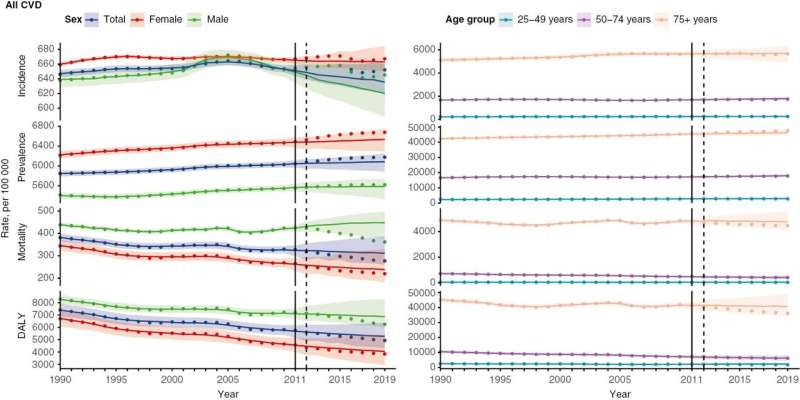Cardiovascular disease (CVD) is a general term for all heart and circulatory diseases, including:
- coronary heart disease
- angina
- heart attack
- congenital heart disease
- hypertension
- stroke
- vascular dementia.
This report highlights progress made by the health and care system in implementing our guidance on CVD prevention.
Published September 2021
Why focus on CVD prevention?
The NHS Long Term Plan suggests that CVD is the biggest area for potential life- saving changes during the next 10 years. The plan prioritises improvements in CVD prevention and management.
People who live in deprived communities or have a learning disability or mental health conditions are more affected by CVD.
- 6 million people live with CVD in England
- £16 billion in combined costs every year
- 1 death every 4 minutes
Key findings from the report
This page provides a summary of the findings from the report.
It includes insight from John Maingay, director of policy and influencing at the British Heart Foundation, about our role in CVD prevention.
We’ve come a long way, but CVD still causes a quarter of all deaths in the UK, and it remains a major driver of health inequalities.
But it doesn’t have to be this way.

Living healthy lives
Most cases of CVD can be prevented through population based interventions and individual lifestyle changes.
Key points: smoking
- Smoking increases the risk of death from CVD. There were almost 28,000 deaths from heart disease connected to smoking between 2017 and 2019.
- Smoking habits vary across ages, genders and socioeconomic status. Smoking rates are higher among people who work in routine and manual jobs. This is compared with people in intermediate or managerial positions. Our guidance and advice on smoking and tobacco aims to prevent people taking up smoking, reduce harm and help people quit.
- Our guideline on smoking in acute, maternity and mental health services promotes smokefree policies. Healthcare professionals should record people’s smoking status during the first face to face contact. People who smoke should be offered advice and support to quit completely.
- In secondary care, the proportion of people who have their smoking status recorded has increased. Referrals to services that help people to stop smoking have decreased.
Insight from John Maingay
“We need to create an environment that supports health and gives everyone the opportunity to live healthy lives.
Further action to reduce smoking rates is also still needed. It is vital that the upcoming tobacco control plan sets out bold, tangible and forward-thinking policy steps to achieve the government’s Smokefree 2030 aim.”
Key points: diet and obesity
- Being overweight or obese can increase the risk of CVD. Between 1993 and 2001, the percentage of adults classed as overweight and obese increased from 53% to 62%. Over 60% of adults in England had a weight classed as overweight or obese in 2019.
- 1 in 10 children starting primary school have a weight classed as obese. In the most deprived areas of the country, rates of obesity in both age groups were more than double those in the least deprived areas.
- Our CVD prevention guideline sets a policy goal to protect children and young people from promotions that encourage an unhealthy diet.
- The provision of mainstream weight management services varies across the country. Where they are provided, NHS England highlights that they are not always designed or targeted to meet the needs of population groups. This includes such groups as people with a learning disability or those with low incomes. This can affect access to and retention within these services.
Insight from John Maingay
“For long-term, positive impact on obesity in the UK, comprehensive action across multiple areas is needed.
The Government’s 2020 obesity strategy made some important commitments to creating a healthier environment. They include pledging to introduce restrictions on the marketing and advertising of foods high in fat, salt and sugar, as well as investing in weight management services.”
Key points: physical activity
- Frequent physical activity is associated with a decreased risk of developing CVD. In June 2019, our quality standard on physical activity: encouraging activity in the community. covered ways in which people of all ages and abilities can be supported and encouraged to be physically active.
- Since 2015, the proportion of adults aged 19 and over who are physically active has remained steady at around two thirds.
- The proportion of active adults was 7% lower in March to May 2020 compared with the same period in 2019.
Key points: alcohol consumption

Diagnosis and management of 3 high-risk conditions
The NHS Long Term Plan aims to prevent 150,000 heart attacks, strokes and cases of vascular dementia over the next 10 years. The plan is to do this by improving the detection and treatment of high-risk conditions that increase CVD risk.
Key points: high cholesterol
High cholesterol can be caused by many different factors. For example, having too much saturated fat in your diet or smoking. It can also be a result of other conditions, like kidney or liver disease.
- Around 40% of men and 45% of women have a diagnosis of high cholesterol.
- Our guideline on cardiovascular disease: risk assessment and reduction, including lipid modification recommends a reduction in the threshold for starting statins. The reduction was to a 10% or more 10-year CVD risk score. The decision whether to start statin therapy should be made after an informed discussion between the clinician and the person.
- Over 66% of people starting statin treatment in 2017 to 2018 had a coded risk score in their medical record. This is a significant increase from just over 4% in 2009 to 2010.
- In June 2016, we published 2 technology appraisals on PCSK9 inhibitors. One was on alirocumab which is for treating primary hypercholesterolaemia and mixed dyslipidaemia and the other on evolocumabwhich is for treating primary hypercholesterolaemia and mixed dyslipidaemia. We recommend their use for people who are unable to reach LDL-C (low-density lipoprotein cholesterol) goals with the maximum tolerated statin dose. This is also recommended for people who cannot have statins.
When it comes to statins, I often find that people are more inclined to try and make healthier lifestyle choices to reduce their cholesterol rather than start taking a new medication.
There seems to be a lot of negativity around statin use and, ultimately, dietary changes can have a bigger impact.
Key points: hypertension (high blood pressure)
- People with hypertension often have no symptoms. 30% of men and 25% of women have hypertension. This includes 14% of men and 11% of women with untreated hypertension.
- In people with diagnosed hypertension, 67% of people under 80 and 82% of people over 80 achieved their blood pressure target in 2019/20.
Insight from John Maingay
“It is important that in-person detection and diagnosis efforts resume as soon as it is safely possible. Services should consider innovative approaches where appropriate, like home blood pressure monitoring.
‘Digital first’ healthcare risks excluding those without digital access or skills. It is important that efforts are made to ensure that everyone can access the care they need, and that alternative solutions are offered where necessary, so that digital healthcare does not create or perpetuate health inequalities.”
Key points: atrial fibrillation
Atrial fibrillation (AF) is a common condition that occurs when there is a problem with the electrical impulses in the upper chambers of the heart. This causes an irregular and often abnormally fast heartbeat. Having AF increases the risk of blood clots in the heart, which can cause a stroke.
- We recommend the CHA2DS2-VASc tool to assess stroke risk. The proportion of people with AF who have been assessed using this tool has remained steady at around 93%. The proportion of people with a score of 2 or more who are treated with anticoagulants has increased, from 81% in 2017 to 87% in 2020.
- Results of a 10-year study of hospitalised AF-related stroke in England indicate that detection has improved. The prevalence of known AF increased from 1.3% to 1.7% from 2006 to 2016.
- New technologies that use artificial intelligence to detect and manage conditions like AF that increase CVD risk are being rolled out. The Zio XT is one such technology. It detects cardiac arrhythmias and is recommended as an option for people suspected of this condition. Especialy people who would benefit from ambulatory electrocardiogram (ECG) monitoring.
- For a long time, warfarin was the most widely prescribed anticoagulant. People who take it must regularly attend clinics to check their blood clotting time and if necessary, have their dose adjusted. In response to the COVID-19 pandemic, some people receiving warfarin were switched to direct-acting oral anticoagulants (DOACs). These do not need regular blood tests in clinics.
I was given a Zio XT to help identify the root cause of my recent fainting, as the normal process to get an ECG was always too late.
The fainting had happened, and it was very likely my heart rhythm would be normal again by the time the ECG was completed.
It was very easy to fit and remove. The results of the 14-day trial were known very quickly and I had a pacemaker fitted within 3 days of the results.
What we’re doing next
Working with external stakeholders
We engaged with external stakeholders while developing this report to identify implementation challenges and available support across the healthcare system.
We will:
- Work with NHS England and NHS Improvement to support the quality improvement work of CVDPrevent and the Accelerated Access Collaborative (AAC).
- Explore further opportunities to engage with their British Heart Foundation’s developing work on health inequalities.
- Strengthen our approach to considering health inequalities and ensure we support the health and care system, where we can best add value.
Creating priority areas for CVD prevention
These stakeholders identified hypertension, AF and cholesterol as the priority areas for CVD prevention. Specific focus is needed on tackling inequalities in detection, management and outcomes.
To help the wider system address these priority areas we will continue to engage with external stakeholders including patient groups
We will do this during the development of the following key CVD prevention guidelines:
More information
This report highlights progress made by the health and care system in implementing NICE guidance. We recognise that change can sometimes be challenging and may require pathway reconfiguration. It may also require additional resources such as training and new equipment.
We work with partners including NHS England and NHS Improvement, Public Health England and other relevant organisations to support changes. We also look for opportunities to make savings by reducing ineffective practice.






